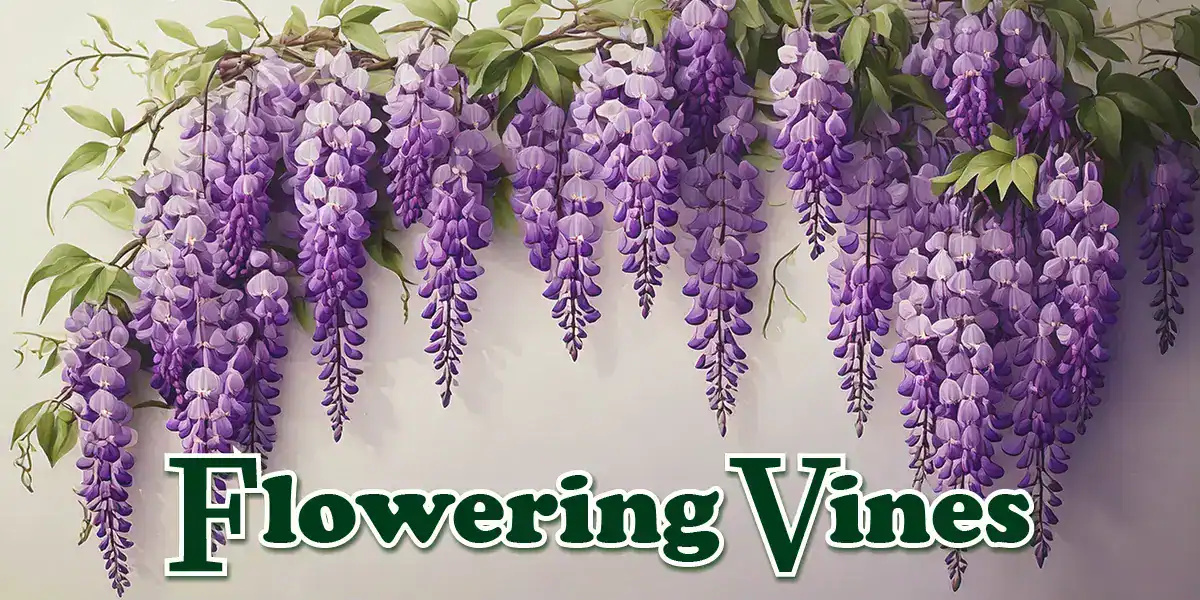Flowering vines can sense vibrations from nearby supports and grow toward them — a remarkable adaptation that makes them peerless problem-solvers in the garden.
While trees and shrubs demand extensive root systems and thick trunks, vines invest their energy in prolific blooms and efficient light-capture.
These climbing specialists offer practical benefits beyond beauty. Wisteria and bougainvillea create natural air conditioning by shading walls. Drought-tolerant species like passionflower flourish with minimal water while producing some of nature’s most spectacular blossoms. Flowering vines can quickly transform challenging spaces into stunning focal points.
12 Flowering Vines That Thrive in SoCal
Drought-tolerance and resilience to high sun exposure ensure healthy growth and vigorous flowering.
Many flowering vines are low-maintenance, pest-resistant, and capable of adapting to the diverse microclimates across the state.
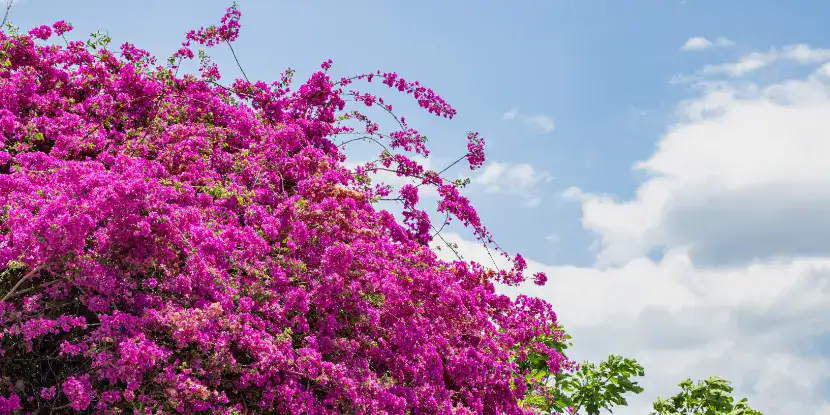
Bougainvillea – A riot of papery blooms that turn walls and fences into explosions of color.
1. Bougainvillea (Bougainvillea spectabilis)
Bougainvillea’s papery bracts form walls of vibrant color year-round. The plant withstands extreme drought and blooms repeatedly throughout the growing season.
Flowers & Appeal
- Spectacular bracts in magenta, purple, orange, red, pink, or white shades.
- Bracts surround small true flowers, creating bold bursts of color.
Growth Habit
- Vigorous, woody evergreen vine with thorny stems.
- Sprawling habit requires support and training to climb.
When to Plant
- Best planted in spring or early summer once frost risk has passed.
Growing Conditions
- Requires full sun for optimal flowering.
- Tolerates poor, dry soils; thrives in warm, arid climates.
Height & Spread
- Can grow 20–30 feet tall and spread equally wide.
Bloom Time
- Blooms nearly year-round in warm California regions, with peak flowering in summer.
Maintenance & Care
- Drought-tolerant once established; avoid overwatering.
- Prune to control size and encourage bushier growth.
- Handle carefully due to sharp thorns.
Best Uses
- Ideal for brightening walls, fences, and arbors with brilliant color.
- Mediterranean or tropical-style gardens.
- Perfect for creating dramatic, long-lasting floral displays in hot climates.
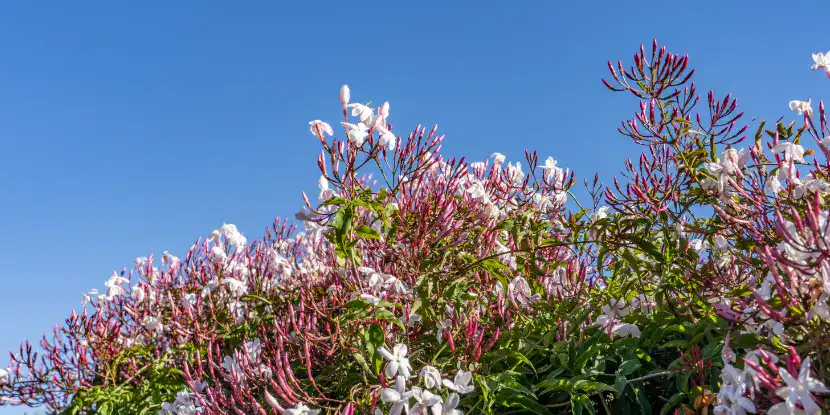
Jasmine – A delicate climber famous for its intoxicating, sweet nighttime fragrance.
2. Jasmine (Jasminum polyanthum)
This fast-growing evergreen vine creates dense coverage while perfuming outdoor spaces. It will bloom even in partial shade, where other plants may struggle.
Flowers & Appeal
- Clusters of pink buds open to fragrant, star-shaped, white flowers.
- Highly valued for its intense sweet fragrance.
Growth Habit
- Fast-growing, twining evergreen vine.
- Can quickly cover trellises, fences, or walls with dense foliage.
When to Plant
- Plant in spring or fall for best establishment.
Growing Conditions
- Prefers full sun to partial shade.
- Thrives in fertile, well-drained soil with moderate moisture.
Height & Spread
- Can grow 20–30 feet tall and spread 10–15 feet wide.
Bloom Time
- Late winter through early spring, providing early-season blooms.
Maintenance & Care
- Prune after flowering to maintain shape and prevent tangling.
- Can become invasive in some areas if not controlled.
Best Uses
- Excellent for pergolas, trellises, and fences where fragrance is desired.
- Beautiful near patios, windows, and entrances to enjoy the scent indoors and outdoors.
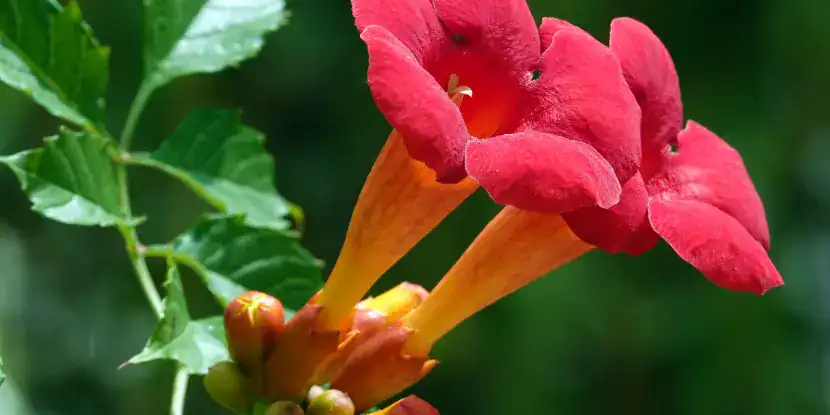
Trumpet Vine – A bold climber with fiery, trumpet-shaped blooms that hummingbirds can’t resist.
3. Trumpet Vine (Campsis radicans)
This aggressive deciduous plant requires regular pruning, but rewards the gardener with non-stop summer blooms.
Flowers & Appeal
- Striking clusters of orange-red tubular blooms loved by hummingbirds.
- Provides bold color and dense greenery in summer gardens.
Growth Habit
- Vigorous deciduous climber using aerial rootlets to cling to surfaces.
- Aggressive spreader; needs firm control and pruning.
When to Plant
- Late winter through early summer.
Growing Conditions
- Full sun to partial shade.
- Tolerates many soil types; thrives in average, well-drained soils.
Height & Spread
- 30–40 feet tall, 5–10 feet wide.
Bloom Time
- Summer through early fall with continuous flowering.
Maintenance & Care
- Requires consistent pruning to control invasive growth.
- Best kept away from house walls to avoid damage from clinging roots.
Best Uses
- Ideal for wildlife gardens and attracting hummingbirds.
- Excellent for covering large fences, walls, and pergolas where vigorous growth is an asset.
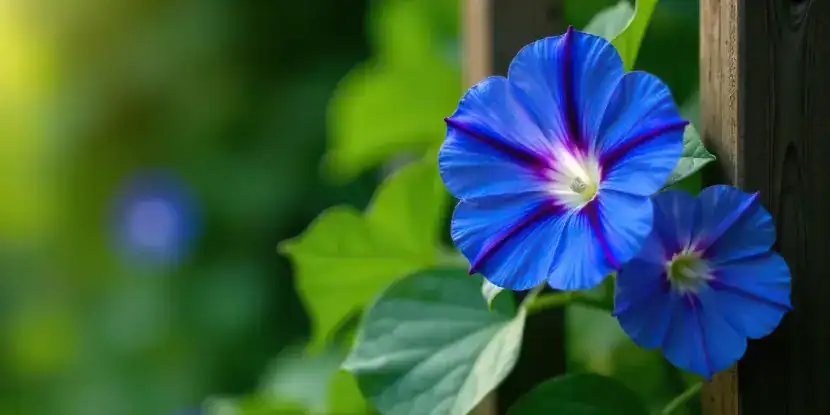
Morning Glory – A fast-growing charmer whose blooms greet the sunrise and vanish by noon.
4. Morning Glory (Ipomoea tricolor)
Seeds planted in spring create full coverage by midsummer. This annual vine produces heart-shaped leaves and trumpet-shaped flowers in blue, purple, pink, or white.
Flowers & Appeal
- Produces trumpet-shaped blooms in blue, purple, pink, or white.
- Paired with lush, heart-shaped foliage for charming seasonal coverage.
Growth Habit
- Fast-growing annual vine, perfect for a quick garden impact.
- Easily grown from seed, often reaching full coverage by midsummer.
When to Plant
- After the last frost in spring (March–April in most California regions).
Growing Conditions
- Prefers full sun.
- Grows best in well-draining soil with regular watering.
Height & Spread
- Typically 6–12 feet tall, 3–6 feet wide.
Bloom Time
- Blooms from summer until the first frost, opening fresh flowers each morning.
Maintenance & Care
- Minimal maintenance—requires little pruning.
- Can reseed itself readily; remove spent vines if self-seeding is not desired.
Best Uses
- Quick screening or seasonal coverage.
- Perfect in containers with trellises or fences.
- Great for children’s gardens or filling spaces while permanent vines establish themselves.
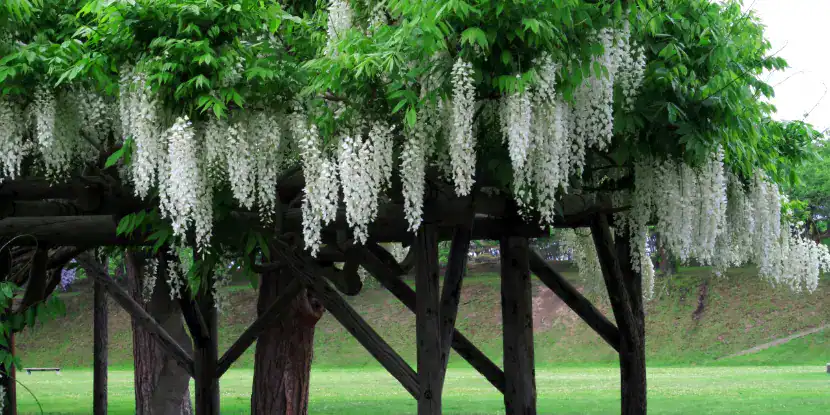
Wisteria – Cascading clusters of lavender or white blossoms that look like floral waterfalls.
5. Wisteria (Wisteria sinensis / Wisteria floribunda)
This hardy plant can live for over 50 years with proper care, and can be trained to climb or shaped into a standalone tree. Either way, it rewards you with a spectacle of lavender, blue, pink, or white blossoms every spring and summer.
Flowers & Appeal
- Dramatic cascading clusters of purple, blue, pink, or white flowers.
- Provides a striking focal point with fragrant, showy blooms.
Growth Habit
- Vigorous deciduous climber with twining stems.
- Long-lived but slow to establish; may take 3–5 years to flower.
- Requires strong support (pergolas, arbors, fences, or sturdy trellises).
When to Plant
- Best planted in fall or early spring for strong root establishment.
Growing Conditions
- Full sun (6+ hours daily) for best flowering.
- Prefers fertile, well-drained soil; slightly acidic to neutral pH.
- Avoid planting too close to homes or delicate structures—roots and stems can be invasive.
Height & Spread
- Can reach 20–30 feet tall and spread 10–15 feet wide with support.
Bloom Time
- Late spring to early summer, sometimes with repeat flowering in late summer.
Maintenance & Care
- Regular pruning (twice yearly: summer and winter) to control growth and maximize blooms.
- Train young vines early to establish shape and structure.
- Drought-tolerant once established, but benefits from deep, occasional watering.
Best Uses
- Ideal for dramatic garden displays and shaded sitting areas.
- Excellent for covering pergolas, arbors, or large trellises.
- Suitable for long-term landscape features where strong, vigorous growth is desired.
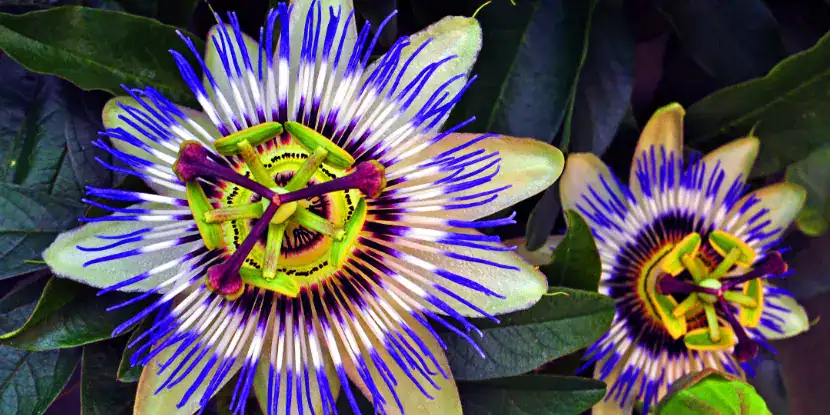
Passion Vine – Exotic, intricate flowers that look like they were engineered by an artist.
6. Passion Vine (Passiflora caerulea)
The blue passion flower produces edible orange fruits that birds love. This evergreen vine handles coastal conditions exceptionally well.
Flowers & Appeal
- Exotic star-shaped flowers with striking purple and blue filaments.
- Produces small orange fruits that add ornamental interest.
Growth Habit
- Vigorous, twining evergreen or semi-evergreen vine.
- Can quickly climb over fences, trellises, or arbors.
When to Plant
- Plant in spring or early summer after frost danger has passed.
Growing Conditions
- Prefers full sun to partial shade.
- Well-drained, fertile soil is best; moderately drought-tolerant once established.
Height & Spread
- Reaches 15–30 feet tall, spreading 10–15 feet.
Bloom Time
- Late spring through early fall.
Maintenance & Care
- Requires occasional pruning to control growth.
- Can spread aggressively in mild climates.
Best Uses
- Ideal for tropical or exotic-style gardens.
- Great for covering fences, arbors, or walls with dramatic blooms.
- Attracts butterflies, especially the Gulf Fritillary.
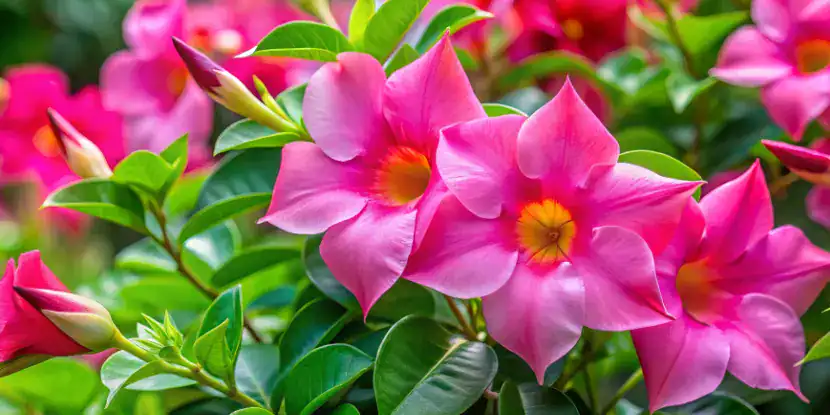
Mandevilla – Tropical elegance with large, velvety blooms in shades of red, pink, or white.
7. Mandevilla (Mandevilla splendens)
This tender perennial vine thrives in containers, making it perfect for renters or gardeners who want flexibility. In frost-free areas, it becomes a permanent landscape feature.
Flowers & Appeal
- Large, trumpet-shaped blooms in shades of pink, red, or white.
- Lush, glossy green foliage offers a tropical look.
Growth Habit
- Evergreen or semi-evergreen twining vine in warm climates.
- Often grown as a container plant in cooler regions.
When to Plant
- Plant in late spring after frost has passed.
Growing Conditions
- Requires full sun to partial shade.
- Thrives in well-drained soil with consistent watering and feeding.
Height & Spread
- Typically 10–20 feet tall when supported.
- Spreads 3–6 feet wide.
Bloom Time
- Summer through fall, sometimes year-round in frost-free areas.
Maintenance & Care
- Needs regular feeding for prolific flowering.
- Prune lightly to shape and encourage bushier growth.
- Sensitive to frost — protect in colder climates.
Best Uses
- Excellent for containers on patios, balconies, or entryways.
- Beautiful on trellises, fences, and pergolas for tropical flair.
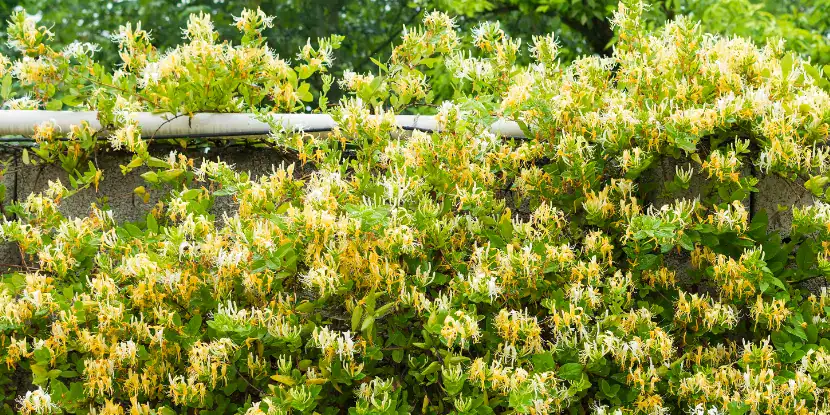
Honeysuckle – Sweet-scented tubes of nectar that attract bees, butterflies, and childhood memories.
8. Honeysuckle (Lonicera japonica)
Japanese honeysuckle fills the air with a sweet fragrance drifting from small white and yellow tubular flowers. However, this evergreen vine requires management to prevent overwhelming other plants.
Flowers & Appeal
- Clusters of tubular white and yellow flowers with a sweet fragrance.
- Loved by hummingbirds and pollinators.
Growth Habit
- Vigorous, twining, semi-evergreen vine.
- Can spread aggressively if not controlled.
When to Plant
- Best planted in spring or fall.
Growing Conditions
- Prefers full sun to light shade.
- Tolerates a wide range of soils, provided they are well-drained.
Height & Spread
- Typically 15–30 feet tall, spreading 6–15 feet wide.
Bloom Time
- Spring through late summer, often with extended flowering.
Maintenance & Care
- Prune regularly to prevent invasiveness and encourage blooms.
- Train early on trellises or fences to control spread.
Best Uses
- Great for covering fences, trellises, or arbors with fragrance and flowers.
- Perfect for wildlife gardens due to nectar-rich blooms.

Clematis – The “queen of climbers,” offering endless varieties of star-shaped flowers.
9. Clematis (Clematis varieties)
Often called the “queen of climbers,” clematis produces flowers in a wide range of colors, shapes, and sizes. With proper care and pruning, it will bloom throughout the growing season.
Flowers & Appeal
- Wide variety of large, showy flowers in many colors and forms.
- Some varieties are fragrant, others are prized for unusual flower shapes.
Growth Habit
- Deciduous or evergreen climbing vine, depending on variety.
- Twines by wrapping leaf stems around supports.
When to Plant
- Fall or early spring.
Growing Conditions
- Prefers full sun to partial shade; flowers like sun, roots like cool soil.
- Needs fertile, well-drained soil; mulch around roots to keep cool.
Height & Spread
- Most varieties grow 8–20 feet tall, spreading 3–6 feet.
Bloom Time
- Highly variable depending on variety: spring, summer, or fall bloomers.
Maintenance & Care
- Pruning requirements vary by group (spring-blooming, summer-blooming, repeat-blooming).
- Needs strong support and careful training.
Best Uses
- Versatile for trellises, fences, and pergolas.
- Can be combined with roses or shrubs for a layered effect.
- Excellent for cottage and formal gardens alike.
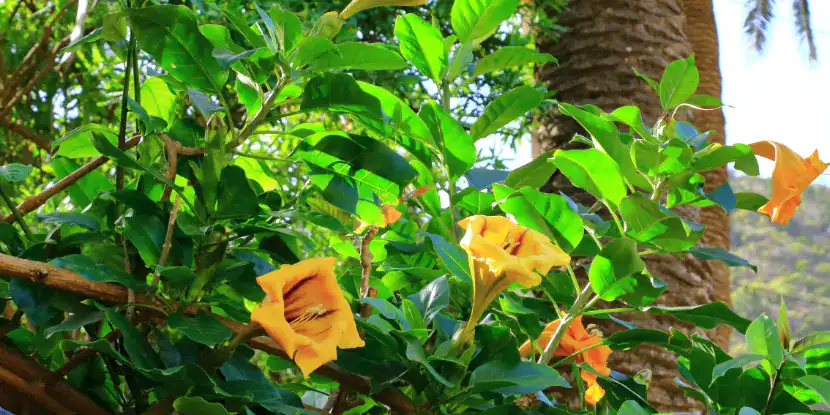
Cup of Gold – A dramatic vine with huge, golden, chalice-shaped blossoms.
10. Cup of Gold (Solandra maxima)
This fast-growing, evergreen vine is known for its large, trumpet-shaped, golden-yellow flowers with a sweet, fragrant aroma. Native to the tropics, it thrives in warm climates and can be trained to climb trellises, walls, or pergolas.
Flowers & Appeal
- Huge golden-yellow, chalice-shaped flowers up to 10 inches across.
- Fragrant, with a sweet scent, especially in the evening.
Growth Habit
- Vigorous evergreen vine with leathery leaves.
- Sprawling climber requiring sturdy support.
When to Plant
- Spring or summer in frost-free areas.
Growing Conditions
- Needs full sun to thrive.
- Prefers well-drained, moderately fertile soil.
- Tolerates coastal conditions.
Height & Spread
- Can grow 30–40 feet tall and spread equally wide.
Bloom Time
- Winter through spring, with sporadic flowering in other seasons.
Maintenance & Care
- Requires strong support due to heavy growth.
- Prune to manage size and encourage blooms.
- Frost sensitive; best in mild coastal or inland climates.
Best Uses
- Perfect for dramatic garden displays with oversized flowers.
- Great for large trellises, pergolas, or walls.
- Adds bold tropical character to landscapes.
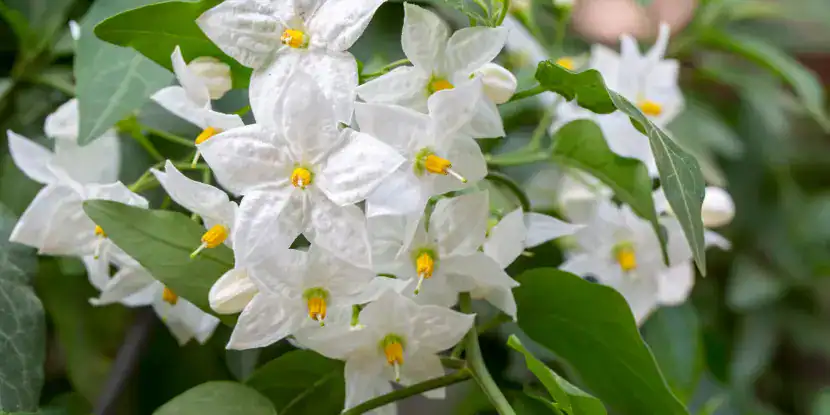
Potato Vine – A hardy, easy grower covered in starry white or lavender-blue flowers.
11. Potato Vine (Solanum laxum)
This evergreen climber bears clusters of small, star-shaped white flowers with yellow centers. Hardy and low-maintenance, it’s well-suited for covering fences, trellises, or walls.
Flowers & Appeal
- Star-shaped clusters of small, fragrant white or pale purple flowers.
- Produces light yellow berries in fall.
Growth Habit
- Fast-growing, semi-evergreen climber.
- Can cover fences or trellises quickly.
When to Plant
- Plant in spring or fall.
Growing Conditions
- Prefers full sun to partial shade.
- Adapts to various soils but prefers well-drained ground.
Height & Spread
- Grows 15–30 feet tall, spreading 10–15 feet wide.
Bloom Time
- Spring through fall, often with continuous flowering in mild climates.
Maintenance & Care
- Easy to grow with minimal pruning needs.
- May need occasional trimming to control spread.
Best Uses
- Excellent for quick coverage of fences, walls, or pergolas.
- Provides a light, airy floral display that blends well with other plantings.
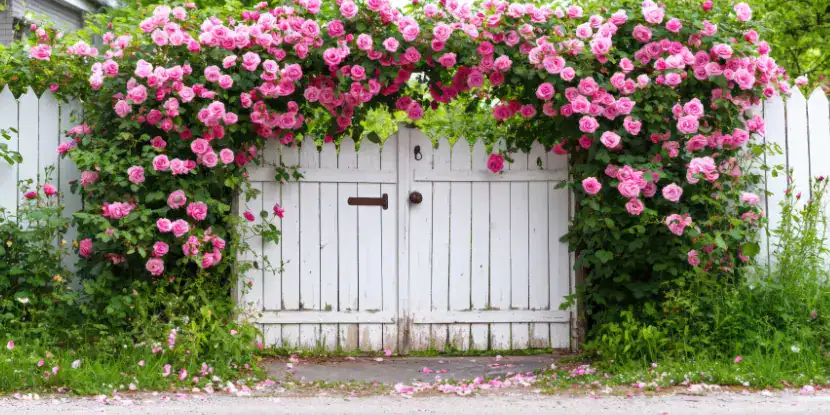
Climbing Roses – Classic romance blending beauty, fragrance, and timeless charm.
12. Climbing Roses
Unlike true vines, climbing roses send out long canes that can be trained on trellises, fences, and arbors. With proper care, they reward gardeners with repeat blooms and classic charm.
Flowers & Appeal
- Large, often fragrant blooms in various colors — red, pink, white, yellow, and more.
- Attracts pollinators and adds classic cottage-garden elegance.
Growth Habit
- Woody perennial with long, arching canes.
- Does not cling on its own — requires tying or support.
When to Plant
- Late winter to early spring, or in fall in mild climates.
Growing Conditions
- Requires full sun for best flowering (at least 6 hours daily).
- Prefers fertile, well-drained soil with regular moisture.
Height & Spread
- Typically 8–20 feet tall, spreading 6–12 feet wide depending on variety.
Bloom Time
- Spring through fall, with many modern varieties offering repeat flowering.
Maintenance & Care
- Prune annually to remove dead wood and shape growth.
- Train canes horizontally along supports to encourage maximum blooms.
- Fertilize regularly during the growing season.
Best Uses
- Ideal for covering fences, arches, pergolas, and walls.
- Perfect for adding romance and fragrance to entryways and garden seating areas.
FAQs: Flowering Vines
Q: What’s the fastest-growing flowering vine for Southern California?
Morning glory and potato vine provide the quickest results, with morning glory reaching full size in a single season and potato vine establishing rapidly for year-round coverage.
Q: Which flowering vines need the least water once established?
Bougainvillea and honeysuckle are the most drought-tolerant plants, requiring minimal supplemental water after their first year of growth.
Q: Can flowering vines damage walls or structures?
Trumpet vine and some clematis varieties attach using rootlets that can damage surfaces. Choose twining vines like jasmine or mandevilla for structures you want to protect.
Q: Which vines work best in partial shade?
Jasmine, passion vine, and clematis tolerate partial shade well, with jasmine preferring some afternoon protection in the hottest inland areas.
Q: What’s the best time to prune flowering vines?
Prune spring-blooming vines immediately after flowering. Summer and fall bloomers can be pruned in late winter before new growth begins.
Q: Do flowering vines attract beneficial insects?
Yes! Passion vine attracts butterflies, trumpet vine draws hummingbirds, and jasmine brings in beneficial pollinators of all types.
Q: Which vines work well in containers?
Mandevilla, smaller clematis varieties, and annual morning glory thrive in large containers with adequate support structures.
Q: How do I prevent flowering vines from taking over my garden?
Choose less aggressive varieties like clematis or mandevilla, and establish regular pruning schedules to maintain the desired size and shape.

